AGR3ENV - EIA Report: Assessing Fishmeal Use in Aquaculture
VerifiedAdded on 2023/03/23
|7
|1713
|41
Report
AI Summary
This report provides an environmental impact assessment (EIA) focusing on the sustainability of using fishmeal in aquaculture. It applies environmental management theories, policies, and practices to evaluate the ecological impact of using fish products as feed for farmed fish. The assessment considers social, health, and cumulative effects, particularly within the maritime sector. It highlights the potential negative environmental impacts, such as the depletion of wild fish populations, and suggests alternative approaches like using herbivorous species or substitute protein products. The report also discusses environmental management strategies, including ecological management as a design process, the science interface policy strategy, and institutional constraints on adaptive governance. It addresses natural resource management policies, conflict resolution principles, and the importance of awareness creation for environmental sustainability. Desklib offers a platform to explore similar solved assignments and past papers.
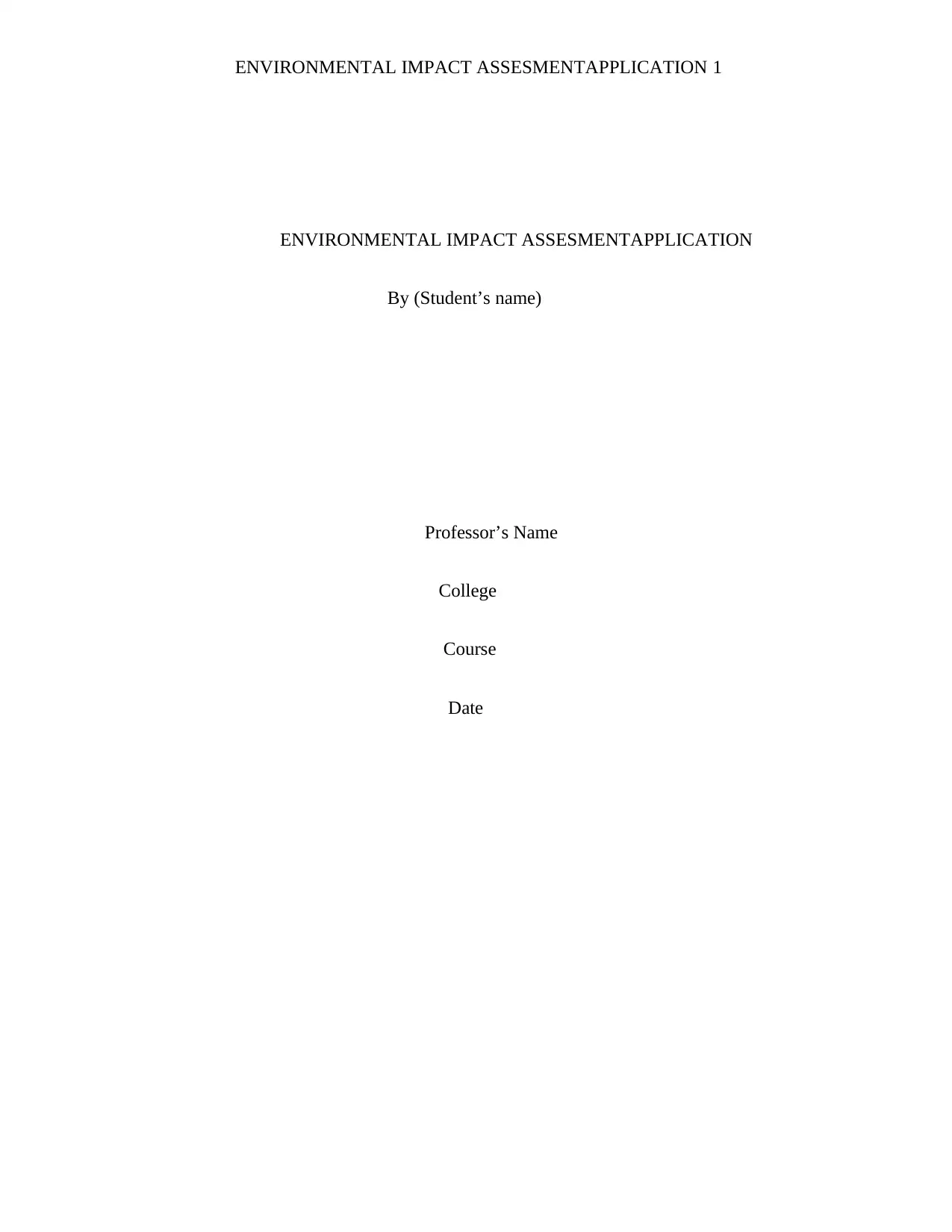
ENVIRONMENTAL IMPACT ASSESMENTAPPLICATION 1
ENVIRONMENTAL IMPACT ASSESMENTAPPLICATION
By (Student’s name)
Professor’s Name
College
Course
Date
ENVIRONMENTAL IMPACT ASSESMENTAPPLICATION
By (Student’s name)
Professor’s Name
College
Course
Date
Paraphrase This Document
Need a fresh take? Get an instant paraphrase of this document with our AI Paraphraser
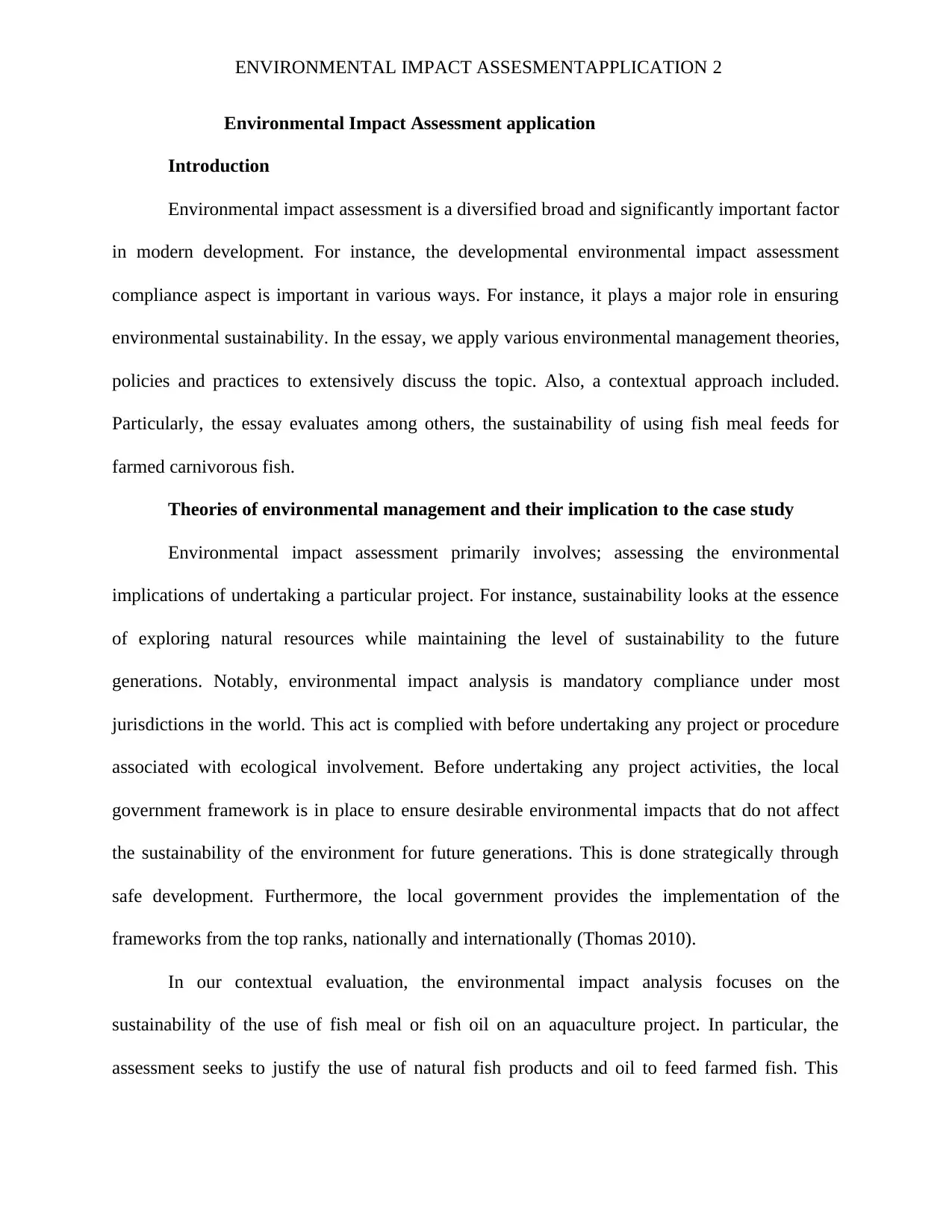
ENVIRONMENTAL IMPACT ASSESMENTAPPLICATION 2
Environmental Impact Assessment application
Introduction
Environmental impact assessment is a diversified broad and significantly important factor
in modern development. For instance, the developmental environmental impact assessment
compliance aspect is important in various ways. For instance, it plays a major role in ensuring
environmental sustainability. In the essay, we apply various environmental management theories,
policies and practices to extensively discuss the topic. Also, a contextual approach included.
Particularly, the essay evaluates among others, the sustainability of using fish meal feeds for
farmed carnivorous fish.
Theories of environmental management and their implication to the case study
Environmental impact assessment primarily involves; assessing the environmental
implications of undertaking a particular project. For instance, sustainability looks at the essence
of exploring natural resources while maintaining the level of sustainability to the future
generations. Notably, environmental impact analysis is mandatory compliance under most
jurisdictions in the world. This act is complied with before undertaking any project or procedure
associated with ecological involvement. Before undertaking any project activities, the local
government framework is in place to ensure desirable environmental impacts that do not affect
the sustainability of the environment for future generations. This is done strategically through
safe development. Furthermore, the local government provides the implementation of the
frameworks from the top ranks, nationally and internationally (Thomas 2010).
In our contextual evaluation, the environmental impact analysis focuses on the
sustainability of the use of fish meal or fish oil on an aquaculture project. In particular, the
assessment seeks to justify the use of natural fish products and oil to feed farmed fish. This
Environmental Impact Assessment application
Introduction
Environmental impact assessment is a diversified broad and significantly important factor
in modern development. For instance, the developmental environmental impact assessment
compliance aspect is important in various ways. For instance, it plays a major role in ensuring
environmental sustainability. In the essay, we apply various environmental management theories,
policies and practices to extensively discuss the topic. Also, a contextual approach included.
Particularly, the essay evaluates among others, the sustainability of using fish meal feeds for
farmed carnivorous fish.
Theories of environmental management and their implication to the case study
Environmental impact assessment primarily involves; assessing the environmental
implications of undertaking a particular project. For instance, sustainability looks at the essence
of exploring natural resources while maintaining the level of sustainability to the future
generations. Notably, environmental impact analysis is mandatory compliance under most
jurisdictions in the world. This act is complied with before undertaking any project or procedure
associated with ecological involvement. Before undertaking any project activities, the local
government framework is in place to ensure desirable environmental impacts that do not affect
the sustainability of the environment for future generations. This is done strategically through
safe development. Furthermore, the local government provides the implementation of the
frameworks from the top ranks, nationally and internationally (Thomas 2010).
In our contextual evaluation, the environmental impact analysis focuses on the
sustainability of the use of fish meal or fish oil on an aquaculture project. In particular, the
assessment seeks to justify the use of natural fish products and oil to feed farmed fish. This
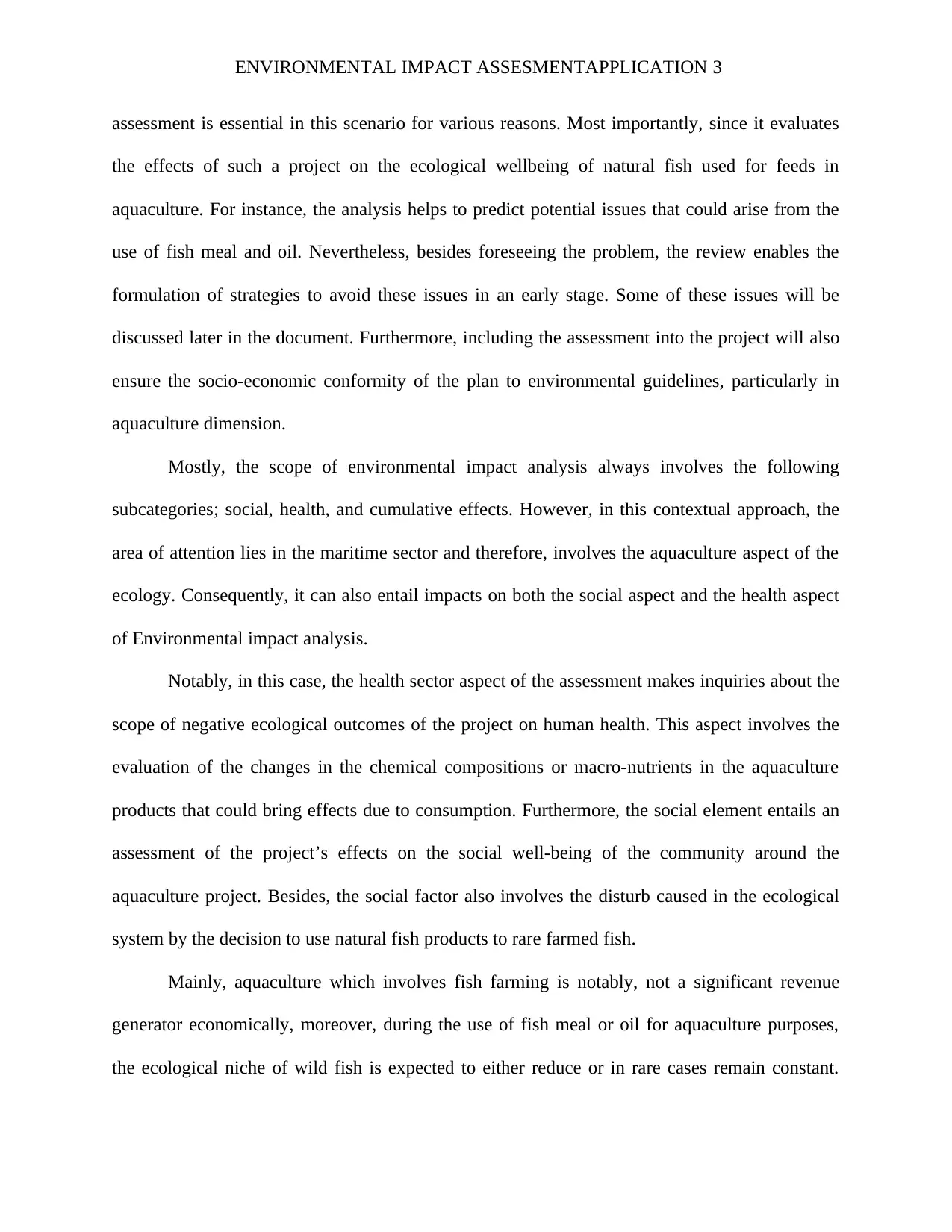
ENVIRONMENTAL IMPACT ASSESMENTAPPLICATION 3
assessment is essential in this scenario for various reasons. Most importantly, since it evaluates
the effects of such a project on the ecological wellbeing of natural fish used for feeds in
aquaculture. For instance, the analysis helps to predict potential issues that could arise from the
use of fish meal and oil. Nevertheless, besides foreseeing the problem, the review enables the
formulation of strategies to avoid these issues in an early stage. Some of these issues will be
discussed later in the document. Furthermore, including the assessment into the project will also
ensure the socio-economic conformity of the plan to environmental guidelines, particularly in
aquaculture dimension.
Mostly, the scope of environmental impact analysis always involves the following
subcategories; social, health, and cumulative effects. However, in this contextual approach, the
area of attention lies in the maritime sector and therefore, involves the aquaculture aspect of the
ecology. Consequently, it can also entail impacts on both the social aspect and the health aspect
of Environmental impact analysis.
Notably, in this case, the health sector aspect of the assessment makes inquiries about the
scope of negative ecological outcomes of the project on human health. This aspect involves the
evaluation of the changes in the chemical compositions or macro-nutrients in the aquaculture
products that could bring effects due to consumption. Furthermore, the social element entails an
assessment of the project’s effects on the social well-being of the community around the
aquaculture project. Besides, the social factor also involves the disturb caused in the ecological
system by the decision to use natural fish products to rare farmed fish.
Mainly, aquaculture which involves fish farming is notably, not a significant revenue
generator economically, moreover, during the use of fish meal or oil for aquaculture purposes,
the ecological niche of wild fish is expected to either reduce or in rare cases remain constant.
assessment is essential in this scenario for various reasons. Most importantly, since it evaluates
the effects of such a project on the ecological wellbeing of natural fish used for feeds in
aquaculture. For instance, the analysis helps to predict potential issues that could arise from the
use of fish meal and oil. Nevertheless, besides foreseeing the problem, the review enables the
formulation of strategies to avoid these issues in an early stage. Some of these issues will be
discussed later in the document. Furthermore, including the assessment into the project will also
ensure the socio-economic conformity of the plan to environmental guidelines, particularly in
aquaculture dimension.
Mostly, the scope of environmental impact analysis always involves the following
subcategories; social, health, and cumulative effects. However, in this contextual approach, the
area of attention lies in the maritime sector and therefore, involves the aquaculture aspect of the
ecology. Consequently, it can also entail impacts on both the social aspect and the health aspect
of Environmental impact analysis.
Notably, in this case, the health sector aspect of the assessment makes inquiries about the
scope of negative ecological outcomes of the project on human health. This aspect involves the
evaluation of the changes in the chemical compositions or macro-nutrients in the aquaculture
products that could bring effects due to consumption. Furthermore, the social element entails an
assessment of the project’s effects on the social well-being of the community around the
aquaculture project. Besides, the social factor also involves the disturb caused in the ecological
system by the decision to use natural fish products to rare farmed fish.
Mainly, aquaculture which involves fish farming is notably, not a significant revenue
generator economically, moreover, during the use of fish meal or oil for aquaculture purposes,
the ecological niche of wild fish is expected to either reduce or in rare cases remain constant.
⊘ This is a preview!⊘
Do you want full access?
Subscribe today to unlock all pages.

Trusted by 1+ million students worldwide
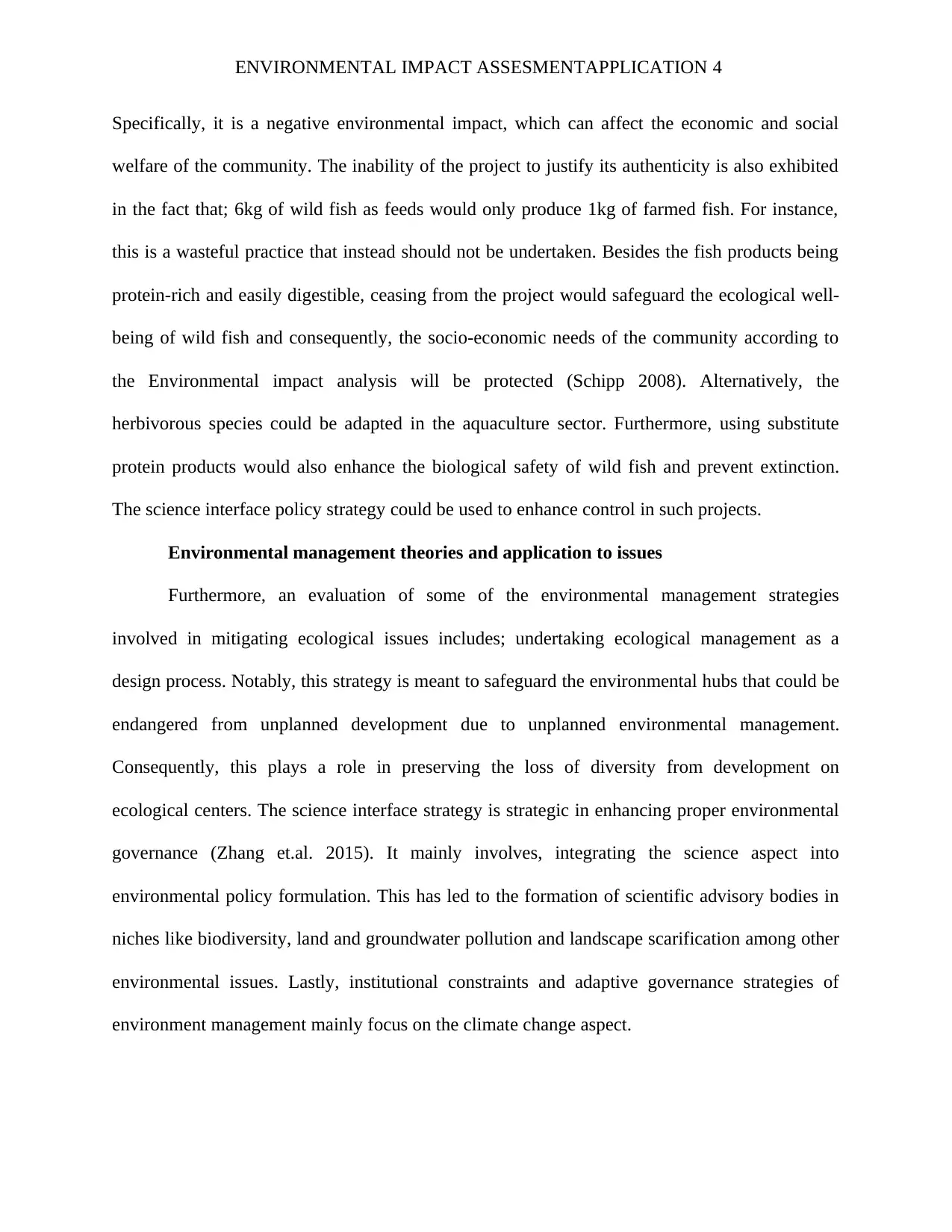
ENVIRONMENTAL IMPACT ASSESMENTAPPLICATION 4
Specifically, it is a negative environmental impact, which can affect the economic and social
welfare of the community. The inability of the project to justify its authenticity is also exhibited
in the fact that; 6kg of wild fish as feeds would only produce 1kg of farmed fish. For instance,
this is a wasteful practice that instead should not be undertaken. Besides the fish products being
protein-rich and easily digestible, ceasing from the project would safeguard the ecological well-
being of wild fish and consequently, the socio-economic needs of the community according to
the Environmental impact analysis will be protected (Schipp 2008). Alternatively, the
herbivorous species could be adapted in the aquaculture sector. Furthermore, using substitute
protein products would also enhance the biological safety of wild fish and prevent extinction.
The science interface policy strategy could be used to enhance control in such projects.
Environmental management theories and application to issues
Furthermore, an evaluation of some of the environmental management strategies
involved in mitigating ecological issues includes; undertaking ecological management as a
design process. Notably, this strategy is meant to safeguard the environmental hubs that could be
endangered from unplanned development due to unplanned environmental management.
Consequently, this plays a role in preserving the loss of diversity from development on
ecological centers. The science interface strategy is strategic in enhancing proper environmental
governance (Zhang et.al. 2015). It mainly involves, integrating the science aspect into
environmental policy formulation. This has led to the formation of scientific advisory bodies in
niches like biodiversity, land and groundwater pollution and landscape scarification among other
environmental issues. Lastly, institutional constraints and adaptive governance strategies of
environment management mainly focus on the climate change aspect.
Specifically, it is a negative environmental impact, which can affect the economic and social
welfare of the community. The inability of the project to justify its authenticity is also exhibited
in the fact that; 6kg of wild fish as feeds would only produce 1kg of farmed fish. For instance,
this is a wasteful practice that instead should not be undertaken. Besides the fish products being
protein-rich and easily digestible, ceasing from the project would safeguard the ecological well-
being of wild fish and consequently, the socio-economic needs of the community according to
the Environmental impact analysis will be protected (Schipp 2008). Alternatively, the
herbivorous species could be adapted in the aquaculture sector. Furthermore, using substitute
protein products would also enhance the biological safety of wild fish and prevent extinction.
The science interface policy strategy could be used to enhance control in such projects.
Environmental management theories and application to issues
Furthermore, an evaluation of some of the environmental management strategies
involved in mitigating ecological issues includes; undertaking ecological management as a
design process. Notably, this strategy is meant to safeguard the environmental hubs that could be
endangered from unplanned development due to unplanned environmental management.
Consequently, this plays a role in preserving the loss of diversity from development on
ecological centers. The science interface strategy is strategic in enhancing proper environmental
governance (Zhang et.al. 2015). It mainly involves, integrating the science aspect into
environmental policy formulation. This has led to the formation of scientific advisory bodies in
niches like biodiversity, land and groundwater pollution and landscape scarification among other
environmental issues. Lastly, institutional constraints and adaptive governance strategies of
environment management mainly focus on the climate change aspect.
Paraphrase This Document
Need a fresh take? Get an instant paraphrase of this document with our AI Paraphraser
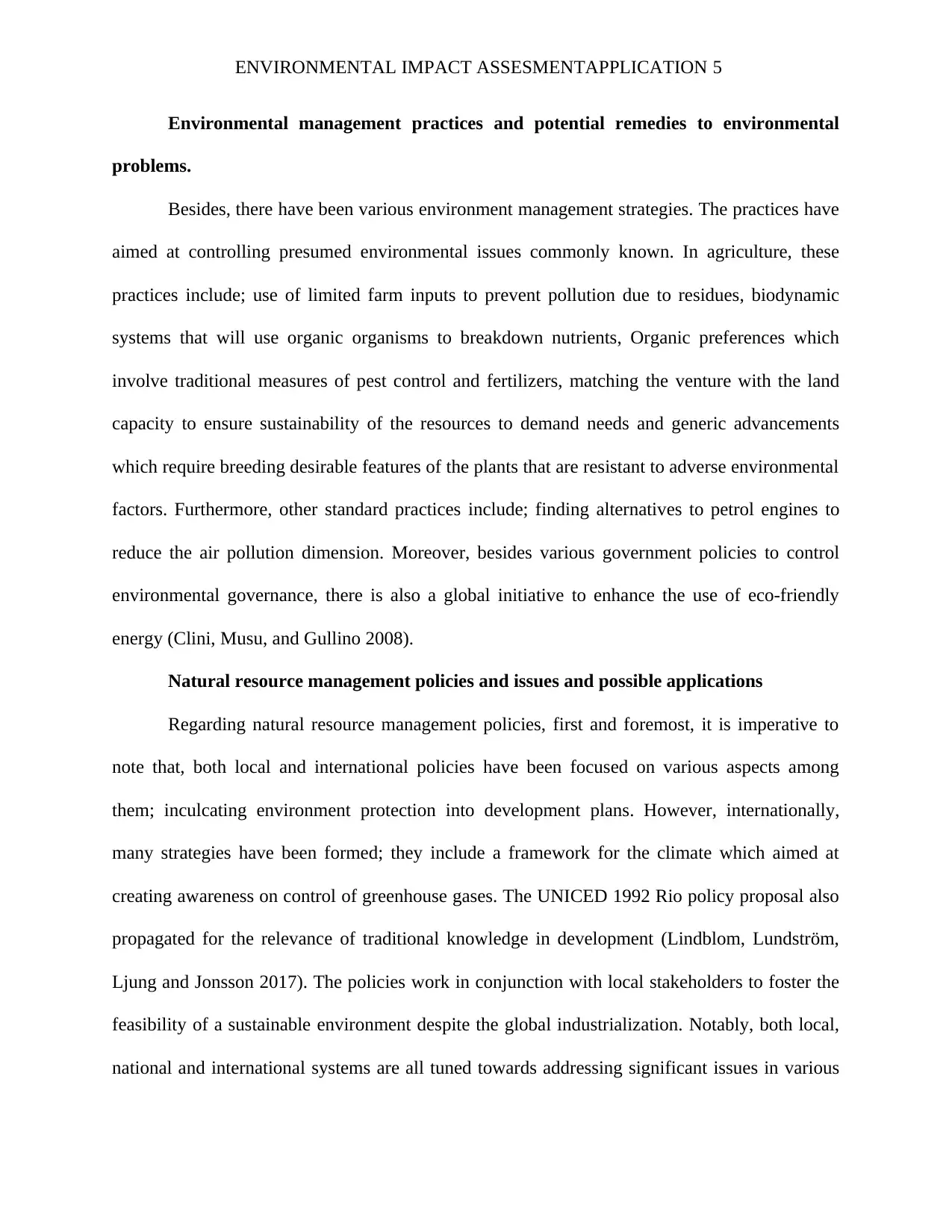
ENVIRONMENTAL IMPACT ASSESMENTAPPLICATION 5
Environmental management practices and potential remedies to environmental
problems.
Besides, there have been various environment management strategies. The practices have
aimed at controlling presumed environmental issues commonly known. In agriculture, these
practices include; use of limited farm inputs to prevent pollution due to residues, biodynamic
systems that will use organic organisms to breakdown nutrients, Organic preferences which
involve traditional measures of pest control and fertilizers, matching the venture with the land
capacity to ensure sustainability of the resources to demand needs and generic advancements
which require breeding desirable features of the plants that are resistant to adverse environmental
factors. Furthermore, other standard practices include; finding alternatives to petrol engines to
reduce the air pollution dimension. Moreover, besides various government policies to control
environmental governance, there is also a global initiative to enhance the use of eco-friendly
energy (Clini, Musu, and Gullino 2008).
Natural resource management policies and issues and possible applications
Regarding natural resource management policies, first and foremost, it is imperative to
note that, both local and international policies have been focused on various aspects among
them; inculcating environment protection into development plans. However, internationally,
many strategies have been formed; they include a framework for the climate which aimed at
creating awareness on control of greenhouse gases. The UNICED 1992 Rio policy proposal also
propagated for the relevance of traditional knowledge in development (Lindblom, Lundström,
Ljung and Jonsson 2017). The policies work in conjunction with local stakeholders to foster the
feasibility of a sustainable environment despite the global industrialization. Notably, both local,
national and international systems are all tuned towards addressing significant issues in various
Environmental management practices and potential remedies to environmental
problems.
Besides, there have been various environment management strategies. The practices have
aimed at controlling presumed environmental issues commonly known. In agriculture, these
practices include; use of limited farm inputs to prevent pollution due to residues, biodynamic
systems that will use organic organisms to breakdown nutrients, Organic preferences which
involve traditional measures of pest control and fertilizers, matching the venture with the land
capacity to ensure sustainability of the resources to demand needs and generic advancements
which require breeding desirable features of the plants that are resistant to adverse environmental
factors. Furthermore, other standard practices include; finding alternatives to petrol engines to
reduce the air pollution dimension. Moreover, besides various government policies to control
environmental governance, there is also a global initiative to enhance the use of eco-friendly
energy (Clini, Musu, and Gullino 2008).
Natural resource management policies and issues and possible applications
Regarding natural resource management policies, first and foremost, it is imperative to
note that, both local and international policies have been focused on various aspects among
them; inculcating environment protection into development plans. However, internationally,
many strategies have been formed; they include a framework for the climate which aimed at
creating awareness on control of greenhouse gases. The UNICED 1992 Rio policy proposal also
propagated for the relevance of traditional knowledge in development (Lindblom, Lundström,
Ljung and Jonsson 2017). The policies work in conjunction with local stakeholders to foster the
feasibility of a sustainable environment despite the global industrialization. Notably, both local,
national and international systems are all tuned towards addressing significant issues in various
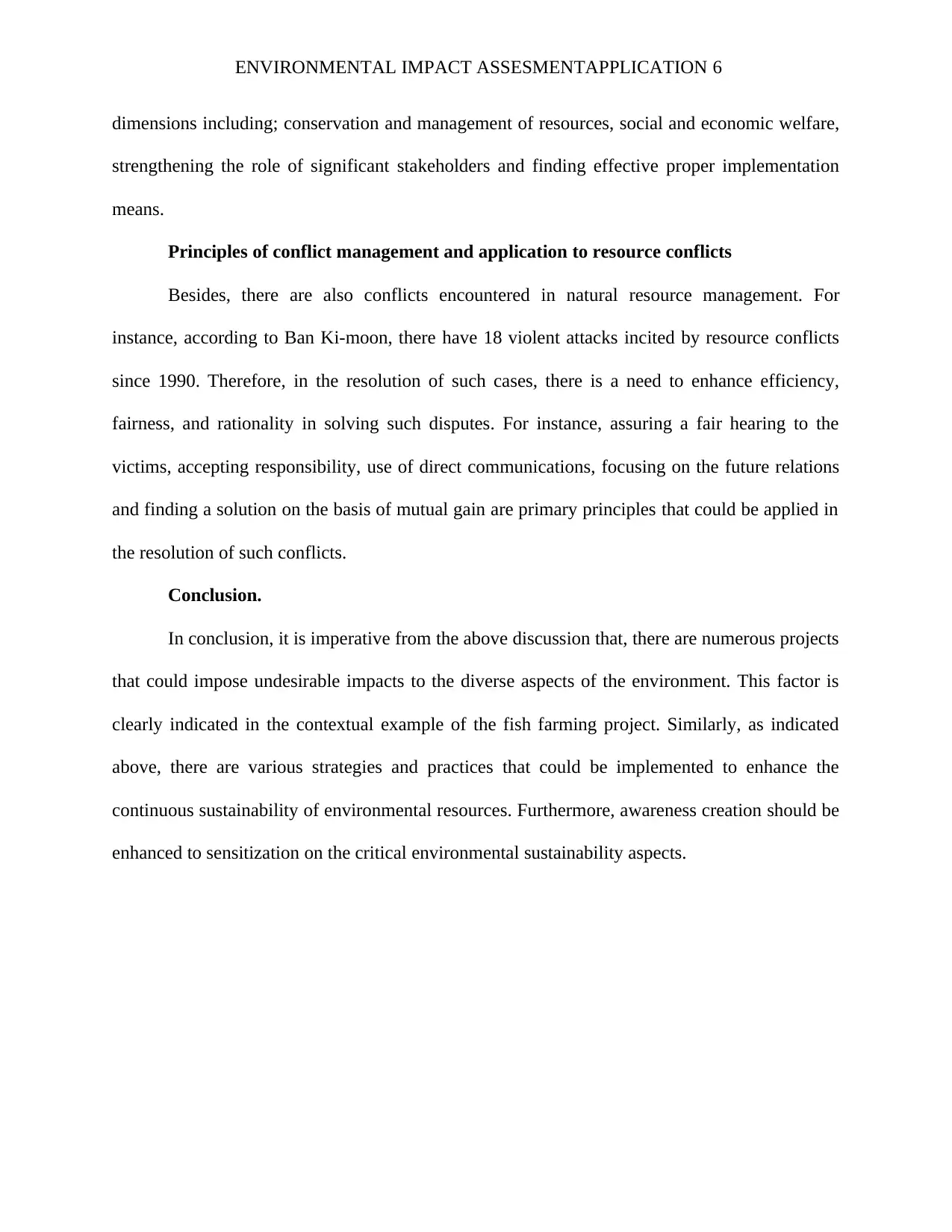
ENVIRONMENTAL IMPACT ASSESMENTAPPLICATION 6
dimensions including; conservation and management of resources, social and economic welfare,
strengthening the role of significant stakeholders and finding effective proper implementation
means.
Principles of conflict management and application to resource conflicts
Besides, there are also conflicts encountered in natural resource management. For
instance, according to Ban Ki-moon, there have 18 violent attacks incited by resource conflicts
since 1990. Therefore, in the resolution of such cases, there is a need to enhance efficiency,
fairness, and rationality in solving such disputes. For instance, assuring a fair hearing to the
victims, accepting responsibility, use of direct communications, focusing on the future relations
and finding a solution on the basis of mutual gain are primary principles that could be applied in
the resolution of such conflicts.
Conclusion.
In conclusion, it is imperative from the above discussion that, there are numerous projects
that could impose undesirable impacts to the diverse aspects of the environment. This factor is
clearly indicated in the contextual example of the fish farming project. Similarly, as indicated
above, there are various strategies and practices that could be implemented to enhance the
continuous sustainability of environmental resources. Furthermore, awareness creation should be
enhanced to sensitization on the critical environmental sustainability aspects.
dimensions including; conservation and management of resources, social and economic welfare,
strengthening the role of significant stakeholders and finding effective proper implementation
means.
Principles of conflict management and application to resource conflicts
Besides, there are also conflicts encountered in natural resource management. For
instance, according to Ban Ki-moon, there have 18 violent attacks incited by resource conflicts
since 1990. Therefore, in the resolution of such cases, there is a need to enhance efficiency,
fairness, and rationality in solving such disputes. For instance, assuring a fair hearing to the
victims, accepting responsibility, use of direct communications, focusing on the future relations
and finding a solution on the basis of mutual gain are primary principles that could be applied in
the resolution of such conflicts.
Conclusion.
In conclusion, it is imperative from the above discussion that, there are numerous projects
that could impose undesirable impacts to the diverse aspects of the environment. This factor is
clearly indicated in the contextual example of the fish farming project. Similarly, as indicated
above, there are various strategies and practices that could be implemented to enhance the
continuous sustainability of environmental resources. Furthermore, awareness creation should be
enhanced to sensitization on the critical environmental sustainability aspects.
⊘ This is a preview!⊘
Do you want full access?
Subscribe today to unlock all pages.

Trusted by 1+ million students worldwide
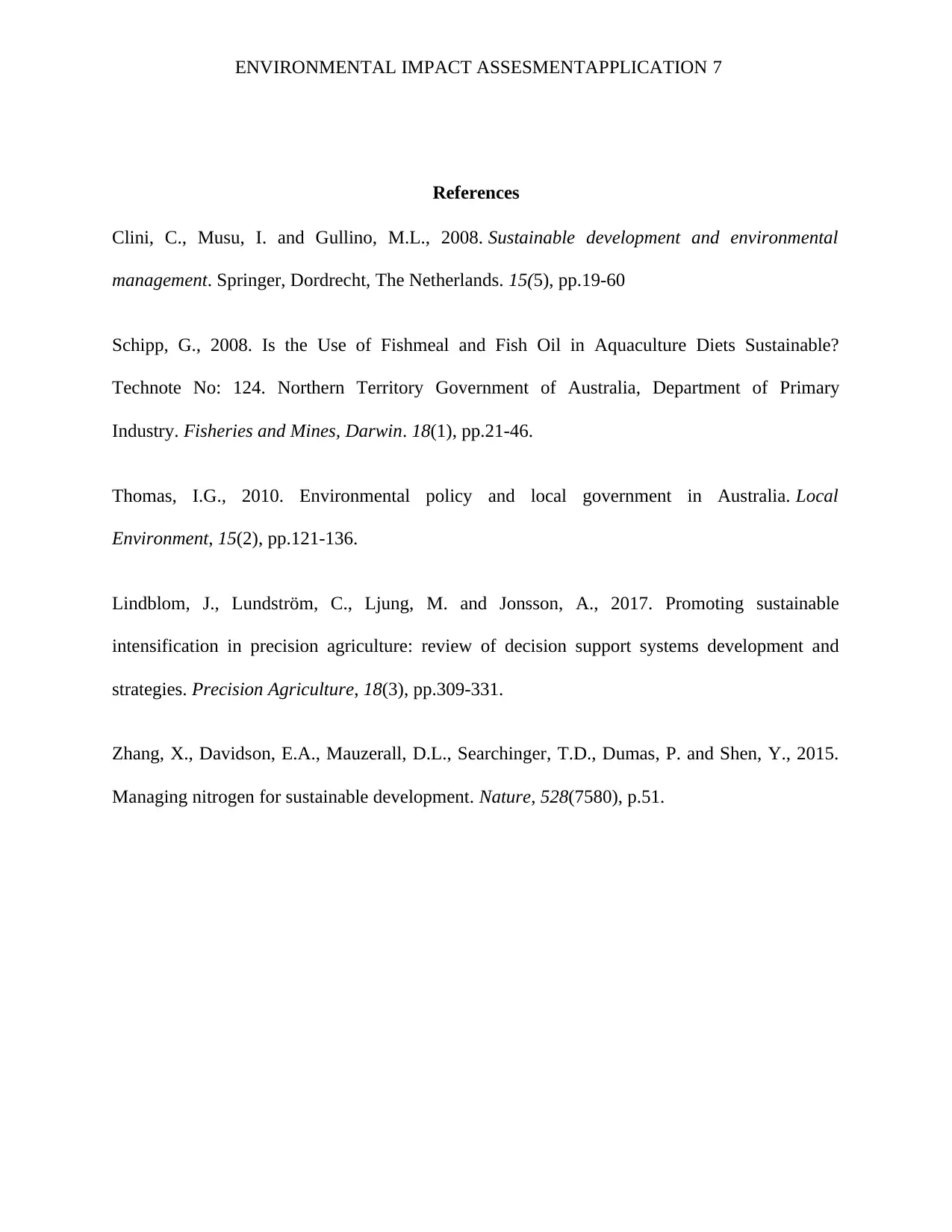
ENVIRONMENTAL IMPACT ASSESMENTAPPLICATION 7
References
Clini, C., Musu, I. and Gullino, M.L., 2008. Sustainable development and environmental
management. Springer, Dordrecht, The Netherlands. 15(5), pp.19-60
Schipp, G., 2008. Is the Use of Fishmeal and Fish Oil in Aquaculture Diets Sustainable?
Technote No: 124. Northern Territory Government of Australia, Department of Primary
Industry. Fisheries and Mines, Darwin. 18(1), pp.21-46.
Thomas, I.G., 2010. Environmental policy and local government in Australia. Local
Environment, 15(2), pp.121-136.
Lindblom, J., Lundström, C., Ljung, M. and Jonsson, A., 2017. Promoting sustainable
intensification in precision agriculture: review of decision support systems development and
strategies. Precision Agriculture, 18(3), pp.309-331.
Zhang, X., Davidson, E.A., Mauzerall, D.L., Searchinger, T.D., Dumas, P. and Shen, Y., 2015.
Managing nitrogen for sustainable development. Nature, 528(7580), p.51.
References
Clini, C., Musu, I. and Gullino, M.L., 2008. Sustainable development and environmental
management. Springer, Dordrecht, The Netherlands. 15(5), pp.19-60
Schipp, G., 2008. Is the Use of Fishmeal and Fish Oil in Aquaculture Diets Sustainable?
Technote No: 124. Northern Territory Government of Australia, Department of Primary
Industry. Fisheries and Mines, Darwin. 18(1), pp.21-46.
Thomas, I.G., 2010. Environmental policy and local government in Australia. Local
Environment, 15(2), pp.121-136.
Lindblom, J., Lundström, C., Ljung, M. and Jonsson, A., 2017. Promoting sustainable
intensification in precision agriculture: review of decision support systems development and
strategies. Precision Agriculture, 18(3), pp.309-331.
Zhang, X., Davidson, E.A., Mauzerall, D.L., Searchinger, T.D., Dumas, P. and Shen, Y., 2015.
Managing nitrogen for sustainable development. Nature, 528(7580), p.51.
1 out of 7
Related Documents
Your All-in-One AI-Powered Toolkit for Academic Success.
+13062052269
info@desklib.com
Available 24*7 on WhatsApp / Email
![[object Object]](/_next/static/media/star-bottom.7253800d.svg)
Unlock your academic potential
Copyright © 2020–2025 A2Z Services. All Rights Reserved. Developed and managed by ZUCOL.



